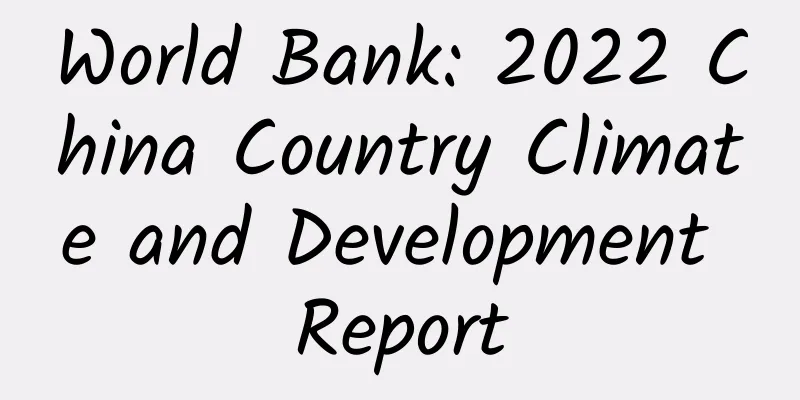World Bank: 2022 China Country Climate and Development Report

|
The China National Climate and Development Report provides analysis and recommendations on how China can coordinate the goals of high-quality development with emission reduction and climate resilience. If China does not take adequate measures to mitigate and adapt to climate change, climate risks will increasingly become a constraint on China's long-term growth and prosperity and may reverse development gains. Therefore, China needs to balance economic growth and green development. This report provides policy options for achieving this dual goal, including reducing the inevitable trade-offs between development and climate goals and maximizing the potential synergies between the two. China's climate ambitions and development opportunities China's development is deeply intertwined with climate change. China is both a major participant in the rise of global greenhouse gas emissions and a deep victim of its adverse effects. Like other major pollutant emitters, China's contribution to reducing global climate-related risks is crucial. Reducing greenhouse gas emissions in the development of a highly carbon-intensive chemical industry economy is not an easy task. This will bring certain transition risks, but also open up rare new development opportunities. This detailed report is firmly based on China's own development goals and climate vision. Climate change poses a major threat to China’s long-term growth and prosperity. Rising sea levels and the risks of coastal flooding, storm surges and coastal erosion threaten China’s densely populated, low-lying coastal cities, which account for one-fifth of China’s population and one-third of its GDP. Meanwhile, inland provinces in northern and western China face more frequent and extreme heat waves and droughts, leading to greater water security risks and affecting agricultural production – a major source of income, especially for China’s rural poor. China's transition to carbon neutrality and resilient development will bring risks and opportunities. While addressing climate risks is critical to ensuring long-term development, China also faces unique challenges in achieving its climate and development goals: China should achieve economic growth and carbon emissions decoupling faster and at a lower income level than developed countries. This means that China's economic structure will undergo a fundamental transformation: major changes will occur in its energy, industrial and transportation systems, cities and land use patterns. Yet China is well-positioned to turn climate action into economic opportunity. As with such dramatic shifts in the past, the transition to lower carbon intensity and adapt to climate change in China and elsewhere in the world will rapidly unleash new sources of economic growth, innovation, and employment, while reducing China’s reliance on imported energy and further improving energy security. |
Recommend
It is obviously a close relative of the cow, so why does it look so much like a deer?
Audit expert: Chen Yu Paleontological restoration...
How much does it cost to make a gardening applet in Guyuan?
How much does it cost to develop the Guyuan Garde...
If a woman is not ruthless, her position will not be stable. Here are 12 unique skills to intimidate men
In love ■Are you experiencing this, too?■ Emotion...
Ballpoint pen becomes a magical tool: it can secretly take pictures of women's skirts
According to the Shenyang Evening News, CCTV recen...
The most complete! Summary of Zhihu’s traffic marketing strategies!
Did you know: What kind of brands are suitable fo...
National Safety Education Day for Primary and Secondary School Students | Keep safety first in mind and embark on the road to success in life!
March 25, 2024 is the 29th National Safety Educat...
Test combination: Can Baidu MTC relieve your pain?
Normal 0 10 pt 0 2 false false false EN-US ZH-CN ...
How to accurately attract traffic and promote the guide
Only with traffic can you make money. In the Inte...
WeChat 8.0.2 is now available! New visitor permissions and 7 new changes
Recently, Apple iOS WeChat released version 8.0.2...
The Ministry of Education released the 2020 National College List: Chongqing has 68 general colleges and universities
Please be careful when filling in your applicatio...
5 Top Traffic Video Marketing and YouTube Video Production Tutorials
For many foreign trade people, video marketing is...
Apple WWDC 2018: Don’t miss any of the highlights, this is a must-read
After much anticipation, the annual Apple WWDC (A...









